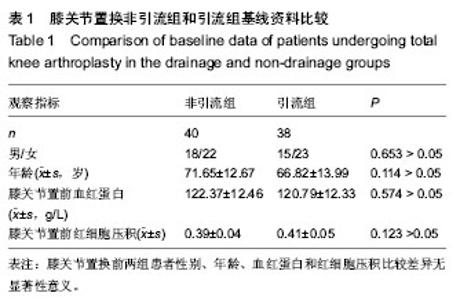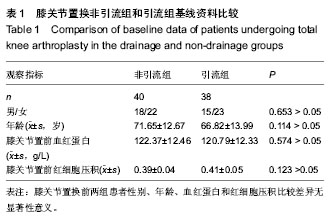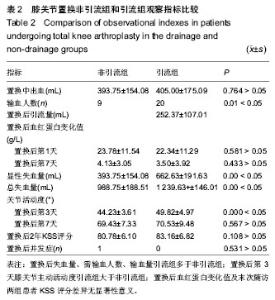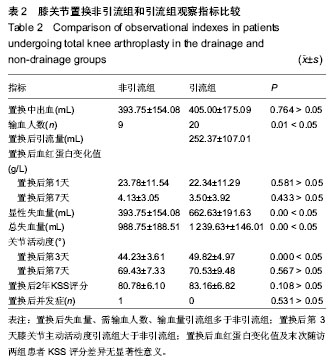| [1] 申延清,刘凤霞,曹红,等.膝骨关节炎患者的临床表现及相关影响因素[J].中国组织工程研究与临床康复,2011,15(9):1643-1646.
[2] Lawrence RC,Felson DT,Helmick CG,et al.Estimates of the prevalence of arthritis and other rheumatic conditions in the United States.Part II.Arthritis Rheum.2008;58(1):26-35.
[3] 林定坤,程志安,杨文斌,等.骨关节炎的健康管理探讨[J].中华健康管理学杂志,2010,4(14):245-248.
[4] Higgs R.Osteoarthritis:Concentrated efforts to detect early OA.Nat Rev Rheumatol.2010;6(11):616.
[5] Garino JP,Beredjiklian PK.成人关节重建与置换 骨科核心知识[M].吕厚山译.北京:人民卫生出版社,2009:69.
[6] 盛林,翁习生,林进,等.全膝关节置换50例:放置引流的随机对照比较[J].中国组织工程研究与临床康复,2009,13(26):5043- 5046.
[7] 徐志辉.人工全膝关节置换术后关节内引流的临床观察[D].山西医科大学,2010.
[8] 翁习生.人工关节置换术的围手术期处理[J].继续医学教育,2006, 20(12):51-68.
[9] Ralley FE,Berta D,Binns V,et al.One intraoperative dose of tranexamic acid for patients ha ving primary hip or knee arthroplasty.Clin Orthop Relat Res.2010;468(7):1905-1911.
[10] 覃健,余存泰,徐中和,等.全髋关节及全膝关节置换术后隐性失血的临床影响[J].中华骨科杂志,2006,26(5):323-326.
[11] 王国伟,孙水,张伟,等.老年骨关节炎全膝置换术疗效影响因素分析[J].山东医药,2008,48(35):19-21.
[12] Bose WJ,Gearen PF,Randall JC,et al.Long-Term outcome of 42 knees with chronic infection after total knee Arthroplasty.Clin Orthop Relat Res.1995;319:285-296.
[13] Hofmann AA,Kane KR,Tkach TK,et al.Treatment of infected total knee arthroplasty using an articulating spacer.Clin Orthop Relat Res,1995;321:45-54.
[14] Waugh TR,Stinchfield FE.Suction drainage of orthopaedic wounds.J Bone Joint Surg,1961;43(7):936-946.
[15] 林进,范彧,常晓,等.一期双侧人工全膝关节置换术后放置引流与不放置引流的对比研究[J].中华医学杂志,2009,89(21):1480-1483.
[16] Reilly TJ,Gradisar IA,Pakan W,et a1.The use of postoperative suction drainage in total knee arthmplasty.Clin Orthop Relat Res.1986;208:238-2.
[17] 孙俊刚,瞿生,袁宏.切口闭合引流对膝关节置换术近期安全性影响的系统评价[J].中华外科杂志,2009,47(20):1544-1549.
[18] 高娜,石跃.一期双侧人工全膝关节置换术后放置引流对患者康复进程的影响[J].中华现代护理杂,2011,17(35):4314-4315.
[19] 翟生,熊道海,武忠眼.切口闭合引流在髋关节置换中作用的系统评价[J].现代中西医结合杂志,2010,19(16):1959-1962.
[20] 陶坤,吴海山,李晓华,等.闭式引流在全膝关节置换术中的作用评价[J].中华外科学杂志,2006,44(16):1480-1483.
[21] 中华医学会风湿病学分会.骨关节炎诊断及治疗指南[J].中华风湿病学杂志,2010,14(6):416-419.
[22] Kellgren JH,Lawrence JS.Radiological assessment of ostoarthrosis.Ann Rheum Dis.1957;16(4):494-502.
[23] 董睿,郭雄.应用Kellgren-Lawrence分级评价成人大骨节病病情的研究[OL].[2011-03-28].中国科技论文在线, http://www.paper.edu.cn/releasepaper/content/201103-1067.
[24] 石士平,李伟,张伟,等.膝骨性关节炎分级与全膝关节置换后隐性失血[J].中国组织工程研究,2013,17(35):6234-6239.
[25] 张纪,张洪.人工膝关节置换术后留置引流与否的对比研究[J].中华外科学杂志,2011,49(12):1119-1122.
[26] Liow RYL, Walker K, Wajid MA, et al.The reliability of the American Knee Society Score.Acta Orthop Scand.2000; 71(6):603-608.
[27] Insall JN,Dorr LD,Scott RD,et al.Rationale of The Knee Society Clinical Rating System.Clin Orthop.1989;(248):13-14.
[28] Saksena J,Platts AD,Dowd GS,Recurrent haemarthrosis following total knee replacement.The Knee,2010;17(1):7-14.
[29] 裴福兴.中国髋、膝关节置换的现状及展望[J].中国骨与关节杂志,2012,1(1):4-8.
[30] Chandratreya A,Giannikas K,Livesley P.To drain or not drain:literature versus practice.Royal College of Surgeons of Edinburgh.1998;43(6):404-406.
[31] Parker MJ,Roberts CP,Hay D.Closed Suction Drainage for Hip and Knee Arthroplasty:A Meta-Analysis.J Bone Joint Surg.2004;86(6):1146-1152.
[32] Drinkwater CJ,Neil MJ.Optimal timing of wound drain removal following total joint arthroplasty.J Arthroplasty,1995; 10(2): 185-189.
[33] Lotke PA,Faralli VJ,Orenstein EM,et al.Blood loss after total knee replacement.Effects of tourniquet release and continuous passive motion.J Bone Joint Surg.1991;73(7): 1037-1040.
[34] Sehat KR,Evans R,Newman JH.How much blood is really lost in total knee arthroplasty?:Correct blood loss management should take hidden loss into account. Knee.2000;7(3): 151-155.
[35] Sinha A,Sinha M,Burgert S.Reinfusion of drained blood as an alternative to homologous blood transfusion after total knee replacement.Int Orthop. 2001;25(4):257-259.
[36] 陈德胜,金群华,李亚平,等.隐性失血对双侧人工全膝关节同期置换手术的影响[J].中国矫形外科杂志,2007,15(17):1290-1292.
[37] 于卫建,陈玫,叶萍,等.大连市6家综合性医院输血反应调查[J].中国输血杂志,2005;18(3):236-237.
[38] 曹力,尼加提.阿不力米提,阿斯哈尔江.买买提明,等.单侧全膝人工关节置换术后引流选择的随机对照研究[J].中华外科杂志, 2009,47(18):1390-1393.
[39] 蔡筑韵,石长贵,鲍哲明,等.人工膝关节置换术后感染危险因素研究进展[J].中华临床医师杂志:电子版,2010,4(7):1045-1048.
[40] Willett KM,Simmons CD,Bentley G.The effect of suction drains after total hip replacement.J Bone Joint Surg.1988; 70(4):607-610.
[41] 喻长纯,杨明路,杜兴升.全膝关节置换后高负压引流下的隐性失血[J].中国组织工程研究,2013,17(48):8313-8318.
[42] 冯敏,符永青,童玉梅,等.Ⅰ期双侧人工全膝关节置换术后放置引流对患者康复进程的影响[J].现代中西医结合杂志,2013,22 (19): 2088-2089,2091.
[43] 齐小鹏,张元凯,李德强,等.TKA术后夹闭和开放引流管对出血量和输血量影响的比较研究[J].医学与哲学,2013,34(22):30-32
[44] 翁习生,边焱焱,周熹,等.人工全膝关节假体覆盖率与术后引流量的关系[J].中国骨与关节外科,2013,(z1):48-51.
[45] 范贵富,罗勇,刘鸿,等.人工关节置换术后感染原因分析及预防对策(附256例报告)[J].中国实用医药,2013,8(21):149-151.
[46] 何雨,牛云峰,闫伟,等.膝关节置换术后引流管早期关闭对出血量的影响[J].中国医学创新,2013,10(10):14-15.
[47] 郝绍文,金群华,杨晓春,等.全膝关节置换术后引流管的拔管时机对隐性失血的影响[J].宁夏医科大学学报,2013,35(8):881- 883,886.
[48] 李灿锋,曾羿,沈彬,等.Quadriceps-Sparing入路与传统入路全膝关节置换术临床疗效的Meta分析[J].中华关节外科杂志(电子版), 2013,7(6):844-851.
[49] 李晖,郑永发,冯世庆,等.全膝关节置换术后不同引流方式的临床对比研究[J].中华骨科杂志,2013,33(08):815-819.
[50] 李娜.术后早期夹闭切口引流在膝关节表面置换术中的优势[J].世界最新医学信息文摘:电子版,2013,(15):104-104.
[51] 张晓南.人工全膝关节表面置换术后引流优越性的meta分析[D].沈阳:中国医科大学,2013.
[52] 傅蔚聪.全膝关节置换术后早期引流管夹闭的临床研究[D].青岛:山东大学,2013. |



